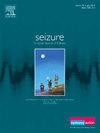Thalamic volumetric analysis in Developmental and/or Epileptic Encephalopathy with Spike Wave Activation in Sleep (D/EE-SWAS): A cross-sectional study
IF 2.7
3区 医学
Q2 CLINICAL NEUROLOGY
引用次数: 0
Abstract
Objectives
This cross-sectional study compared the thalamic volume (TV) of children with Developmental and/or Epileptic Encephalopathy with Spike-Wave Activation in Sleep (D/EE-SWAS) with age matched children with well-controlled epilepsy(WCE).
Methods
An unaided eye assessment of T1-weighted brain MRI sequences and quantitative volumetric analysis through “volBrain” online software was performed in children (5–12 years) with steroid-naïve D/EE-SWAS {spike-wave-index(SWI) in sleep≥50 %} and typically developing children with WCE (seizure-free period ≥1-year). The absolute and relative thalamic volume (ATV/RTV) (RTV: thalamic volume as percentage of the total intracranial volume), were compared between the two groups.
Results
Twenty-children each with D/EE-SWAS (14 boys; mean age: 8.05±1.76 years) and WCE (15 boys; mean age: 9.1 ± 1.74 years) were analysed. In the D/EE-SWAS group, (16/20) 80% of participants had a structural lesion while all the children in the WCE group had a presumed genetic etiology. Volumetric analysis detected low ATV (<2 standard deviation) in 12/20 (60 %) children with D/EE-SWAS while unaided eye assessment could pick up thalamic involvement only in six (30 %). On comparison with WCE group (N = 20), mean ATV and RTV in structural D/EE-SWAS (n = 16) [(7.25 cm3 ± 1.66 versus 11.17 cm3 ± 1.22; p < 0.0001)(0.73 % ± 0.17 versus 0.87 % ± 0.05; p < 0.001)] and presumed genetic D/EE-SWAS (n = 4) [(9.25 cm3 ± 0.55, versus 11.17 cm3 ± 1.22, p < 0.01)(0.74 % ± 0.04 versus 0.87 % ± 0.05; p < 0.0001)] were significantly reduced. ATV did not correlate with SWI in sleep EEG (r =-0.25) in D/EE-SWAS.
Conclusion
Thalamic volume is reduced in majority of children with D/EE-SWAS in both structural and presumed genetic etiology.
发展性和/或癫痫性脑病伴睡眠尖峰波激活(D/EE-SWAS)的丘脑体积分析:一项横断面研究
目的:本横断面研究比较发展性和/或癫痫性脑病伴睡眠尖波激活(D/EE-SWAS)患儿的丘脑体积(TV)与年龄匹配的控制良好的癫痫患儿(WCE)。方法对5 ~ 12岁steroid-naïve D/EE-SWAS{睡眠时峰波指数(SWI)≥50%}和典型发育期WCE患儿(无发作期≥1年)进行t1加权脑MRI序列的裸眼评估和定量体积分析。比较两组的绝对丘脑体积和相对丘脑体积(ATV/RTV) (RTV:丘脑体积占颅内总体积的百分比)。结果D/EE-SWAS患儿各20例(男童14例;平均年龄:8.05±1.76岁)和WCE(15名男孩;平均年龄:9.1±1.74岁)。在D/EE-SWAS组中,(16/20)80%的参与者有结构性病变,而WCE组中所有的儿童都有假定的遗传病因。容量分析在12/20 (60%)D/EE-SWAS儿童中检测到低ATV (<;2个标准差),而单独的眼睛评估仅在6例(30%)中发现丘脑受累。与WCE组(N = 20)比较,结构D/EE-SWAS (N = 16)的平均ATV和RTV [(7.25 cm3±1.66∶11.17 cm3±1.22;p & lt;0.0001)(0.73%±0.17 vs . 0.87%±0.05;p & lt;0.001)]和推测的遗传D/EE-SWAS (n = 4) [(9.25 cm3±0.55,对11.17 cm3±1.22,p <;0.01)(0.74%±0.04 vs . 0.87%±0.05;p & lt;0.0001)]显著降低。D/EE-SWAS组睡眠EEG中ATV与SWI无相关性(r =-0.25)。结论大多数D/EE-SWAS患儿的丘脑体积在结构和推测的遗传病因中均有所减少。
本文章由计算机程序翻译,如有差异,请以英文原文为准。
求助全文
约1分钟内获得全文
求助全文
来源期刊

Seizure-European Journal of Epilepsy
医学-临床神经学
CiteScore
5.60
自引率
6.70%
发文量
231
审稿时长
34 days
期刊介绍:
Seizure - European Journal of Epilepsy is an international journal owned by Epilepsy Action (the largest member led epilepsy organisation in the UK). It provides a forum for papers on all topics related to epilepsy and seizure disorders.
 求助内容:
求助内容: 应助结果提醒方式:
应助结果提醒方式:


